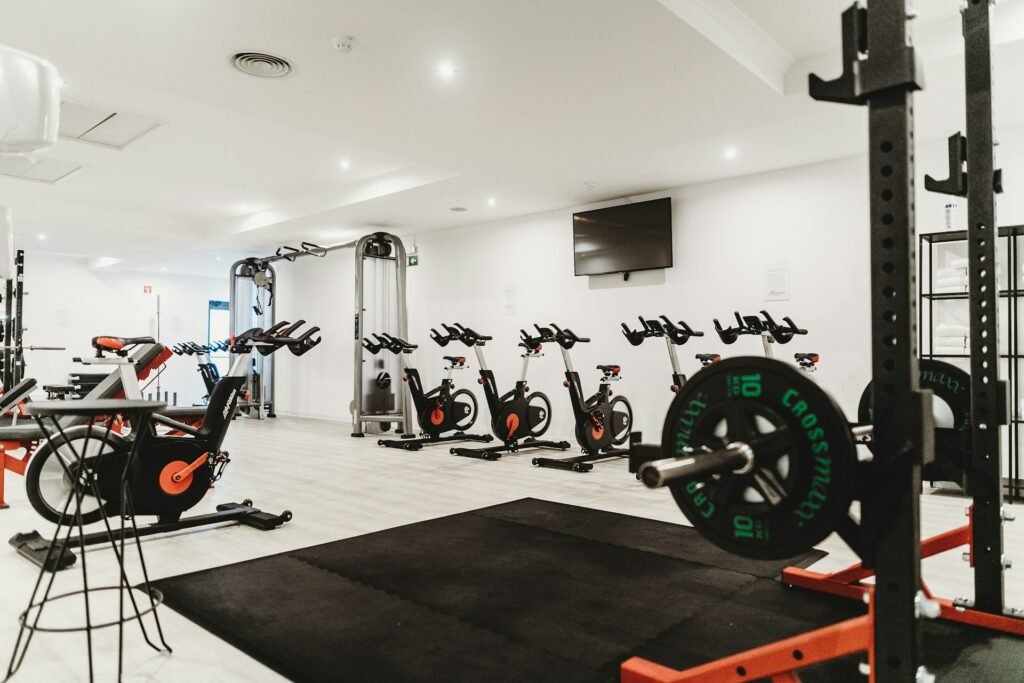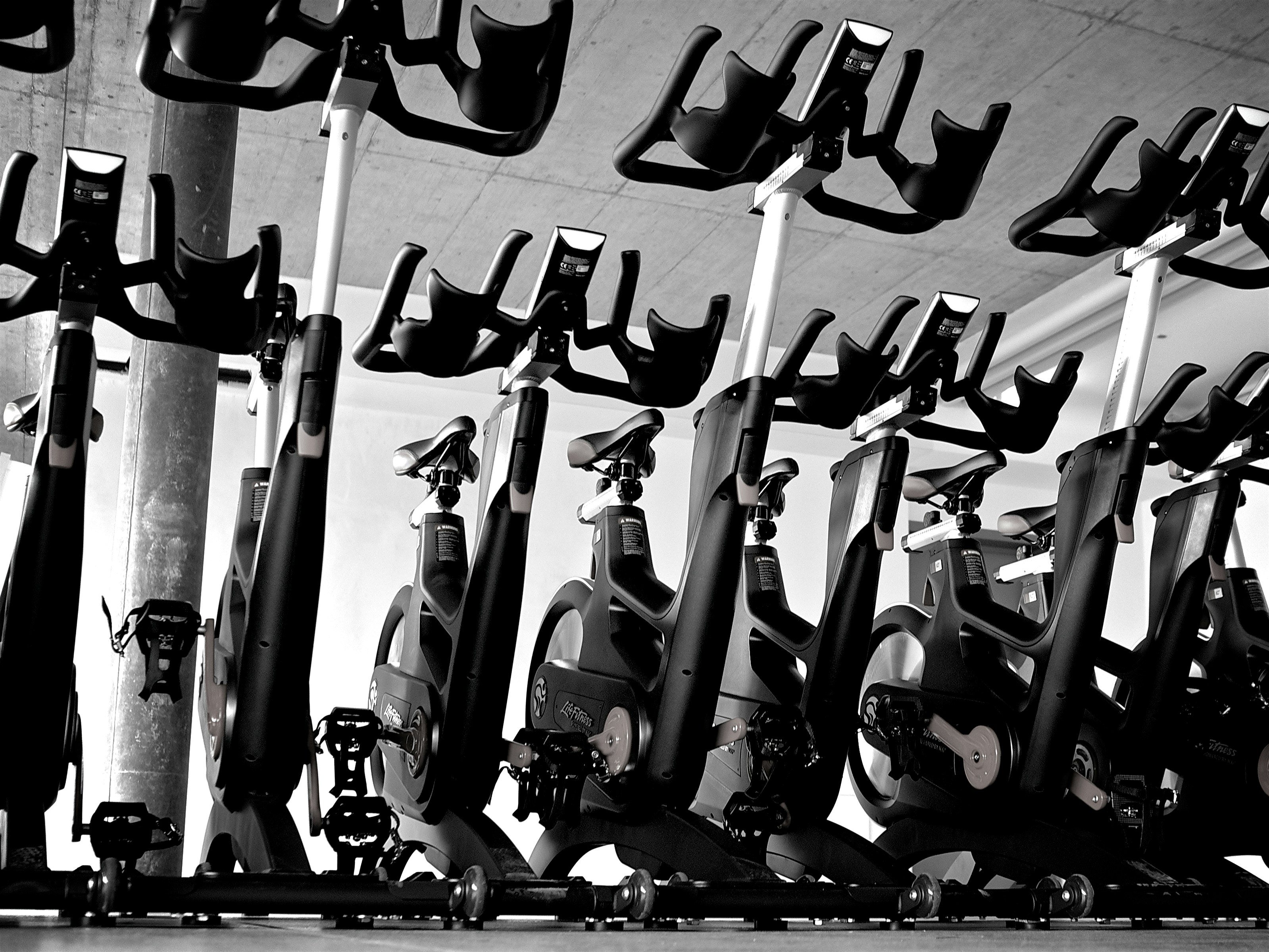
Photo by Humphrey Muleba on Unsplash
Indoor cycling has become a popular choice for those looking to lose weight effectively. This intense cardio workout not only helps in burning a substantial amount of calories but is also gentle on the joints compared to other high-impact exercises like running. According to Harvard scientists, a moderate pace on a stationary bike helps a 155-pound person burn between 260 and 298 calories in just 30 minutes. If the pace is increased to fast, the same individual can burn between 372 and 614 calories in the same amount of time (source).
The beauty of indoor cycling lies in its adaptability to different fitness levels and its accessibility. Whether it’s rainy or sunny outside, the indoor bike provides a consistent workout environment. This consistency is crucial for maintaining a regular exercise regimen, which is essential for long-term weight loss success. Moreover, the ability to adjust resistance levels allows individuals to continually challenge themselves as their fitness improves, ensuring that the workout remains effective over time.
For further insights on how many calories various cardio workouts can burn, exploring our comprehensive guide might provide additional clarity: How Many Calories Does Indoor Cycling Burn?. This can help tailor your workouts to meet your personal weight loss goals more precisely.
Calories Burned: A Deep Dive into Indoor Cycling
Indoor cycling is a popular choice for those looking to burn calories efficiently. It involves riding a stationary bike, which can provide a rigorous cardiovascular workout with significant calorie burn. Generally, the calories burned during indoor cycling vary based on several factors including the cyclist’s weight, intensity of the workout, and duration of the exercise.
On average, a person weighing around 155 pounds can burn approximately 260 to 420 calories in a 30-minute indoor cycling session depending on the intensity of the exercise. Those who weigh more will typically burn more calories; for instance, someone weighing 185 pounds might burn between 311 and 466 calories in the same timeframe. This makes indoor cycling an excellent option for calorie expenditure, especially when considering the convenience and controlled environment it provides, allowing for year-round fitness consistency.
The calorie burn from indoor cycling is comparable to many other forms of cardiovascular exercise, but it has the added benefit of lower impact on the joints. This aspect makes it particularly useful for individuals looking for effective workouts that are easier on the body.
For more insights on choosing between indoor cycling and other cardio machines for maximum calorie burn, visit our comparison of treadmills and exercise bikes.
In conclusion, engaging in regular indoor cycling classes or sessions can contribute significantly to one’s calorie-burning goals, forming an essential part of a balanced weight loss or fitness regimen. For detailed information on calorie expenditure during indoor cycling, refer to the useful insights provided by Blink Fitness here.
Designing an Effective Indoor Cycling Weight Loss Program
Designing an effective indoor cycling weight loss program involves more than just pedaling away on your bike. A combination of structured training and a targeted nutritional strategy is key for effective weight loss. Start by setting clear, achievable goals that focus on performance, such as improving your time on a particular route or distance. This helps in maintaining motivation and gives a clear direction to your efforts.
When designing the training portion of your program, incorporate a mix of high-intensity interval training (HIIT) and endurance rides. High-intensity intervals are excellent for burning calories and boosting cardiovascular health, while longer, steadier rides can help build endurance and promote fat burning. According to TrainerRoad, structured training that adapts to your fitness level can significantly aid in increasing your power output, which is crucial for burning more calories TrainerRoad Basics.
Nutrition also plays a critical part in weight loss. Aim to create a calorie deficit while still fueling your body for the rides. Start by determining your daily caloric needs and reduce that number by 500 to create a deficit, ensuring you still get sufficient nutrients to recover and build muscle. Focus on a diet rich in proteins, healthy fats, and carbohydrates that are timed around your training sessions to maximize energy and recovery.
Consistency is your greatest ally in weight loss. Regularly recording your rides, diet, and weight can help you stay on track and adjust your program as needed based on the progress you’re making. Remember, the scale isn’t the only indicator of success; improvements in your cycling performance are equally significant markers of your progress.
Finally, consider visiting other related topics such as the Benefits of Steady State Cardio to integrate different forms of cardio that could enhance your cycling plan.
What to Eat When Focusing on Weight Loss Through Indoor Cycling

Photo by Jonathan Pielmayer on Unsplash
When engaging in indoor cycling with a focus on weight loss, your diet plays a crucial role in fueling your rides and recovering effectively. Before your cycling session, it’s beneficial to eat a small meal or snack to provide the energy needed for an intense workout. Foods like a small banana, a slice of whole-grain toast with jam, or a handful of cereal can offer the quick energy your body requires. Eating these foods about 30 minutes before you start cycling helps activate the thermic effect of food, which can increase calorie burning (Verywell Fit, 2023).
Post-workout nutrition is equally important. Within an hour of your cycling workout, it’s advisable to consume a mix of carbohydrates and protein to help replenish muscle glycogen and aid in muscle recovery. Options such as low-fat chocolate milk or a combination of walnuts and a pear provide both essential nutrients. This strategy not only aids recovery but also helps maintain a more effective metabolism, ensuring readiness for your next session.
Also, staying hydrated before, during, and after your indoor cycling routine is key. Proper hydration maintains your metabolic rate and supports overall health, enhancing your weight loss efforts.
For more insights on optimizing your indoor cycling sessions for better calorie burn, you may also explore the differences between indoor cycling and spinning.
By aligning your nutritional intake with the demands of indoor cycling, you can more effectively manage your weight and enhance your overall fitness.
How to Steer Clear of Common Weight Loss Traps with Indoor Cycling
Losing weight through indoor cycling can be effective, but it’s easy to fall into some common traps. One of the biggest mistakes is overestimating the number of calories burned during a workout. For instance, an intense three-hour bike ride might burn around 1800 calories, but if you consume high-calorie sports drinks and snacks during the ride, you might end up with a much smaller calorie deficit than needed for weight loss British Cycling.
A practical tip to avoid this trap is to precisely track both your caloric intake and the calories burned. Remember, technologies such as power meters can offer more accurate measurements, as estimates from devices that calculate burn based on heart rate or mere activity level can vary significantly.
Another common error is relying solely on what is often referred to as the “fat-burning zone.” This is a lower intensity level where the body is presumed to burn more fat. However, because the overall calorie expenditure at this level is low, the total fat calories burned might also be lower than expected.
Combining your indoor cycling routine with a well-managed diet is also crucial. On days you are not riding, consider reducing your carbohydrate intake, and always ensure you are not eating more because you feel you “earned it” from cycling. For further insights, refer to Indoor Cycling Benefits and Disadvantages.
By taking into account these aspects, you can make indoor cycling a powerful tool for weight loss without falling into common dietary and workout misconceptions.
Analyzing Workout Intensities: Best Practices for Shedding Pounds

Photo by David Marioni on Unsplash
When it comes to losing weight through exercise, understanding the intensity and type of workout is key. Studies show that integrating a mix of aerobic and resistance training can be effective for fat loss. For instance, a research highlighted by Carla E. Cox, found distinct differences in the impact of these exercises on body composition Source: Carla E. Cox – Diabetes Spectrum, PMC5556592. Aerobic exercises, such as running or cycling, were associated with more significant weight and fat loss compared to resistance training over an eight-month period.
However, the intensity and duration of exercise are crucial for effective weight loss. Evidence suggests that workouts exceeding the general health recommendations (150 minutes per week of moderate-intensity activity) are more effective for weight reduction. A study involving obese men showed that daily exercise leading to a 700-calorie expenditure resulted in notable weight loss comparable to that achieved through dietary restrictions alone.
Moreover, research suggests that consistent, long-term exercise routines are needed to maintain weight loss. Data from the National Weight Control Registry underscores that regular physical activity contributes to sustained weight maintenance after initial weight loss.
Understanding these dynamics can guide your exercise choices. If shedding pounds is your goal, incorporating longer durations of moderate to high-intensity aerobic exercises can be particularly beneficial. You might find it helpful to read more about various cardio exercises and their specific benefits on our detailed page about indoor cycling versus treadmill workouts, which discusses different approaches for calorie burning and weight management.
The Importance of Tracking and Adjusting Your Weight Loss Plan
When you’re trying to lose weight, keeping track of your progress and making necessary adjustments is crucial. It allows you to see what is working and what isn’t. For instance, if you record your daily food intake and physical activities, you might notice that certain eating habits or exercises are more effective at helping you lose weight.
Tracking also helps in maintaining your motivation. Seeing gradual progress, like a slight weekly weight loss, can boost your morale and encourage you to keep going. Conversely, if you hit a plateau, your records can help you identify what changes you need to make. Perhaps you need to tweak your diet or intensify your workouts.
Moreover, accountability plays a big role in weight management. By monitoring your actions, you hold yourself responsible, which can significantly enhance your commitment to your weight loss journey. For example, sharing your progress with friends or a support group can increase your sense of accountability.
For further reading on maintaining a healthy balance between cardio and weight training which can be essential for effective weight loss, visit our detailed page on how much cardio per week to lose belly fat.
Ultimately, adjusting your plan based on what you track ensures that your weight loss efforts are realistic and tailored to your personal needs. This personalized approach not only makes your plan sustainable over the long term but also maximizes your success.
Top Questions About Losing Weight with Indoor Cycling Answered
Many people turn to indoor cycling as a method to lose weight, but often have queries about its effectiveness and best practices. Here are answers to some of the most common questions:
1. Does indoor cycling reduce belly fat?
Indoor cycling can indeed aid in reducing belly fat, but this only happens when it’s part of a consistent workout regimen combined with a calorie-controlled diet. The key to losing weight, including belly fat, is creating a calorie deficit. Indoor cycling contributes to burning calories, helping achieve that deficit necessary for weight reduction [(source)[-1-]](https://www.nutritiontriathlon.com/blog/how-effective-is-indoor-cycling-for-weight-loss).
2. How much indoor cycling should I do to lose weight?
For beginners, starting with shorter sessions of about 10-15 minutes, three times a week, is advisable. Consistency and gradually increasing the duration and intensity as your fitness improves will help sustain a calorie deficit, facilitating long-term weight loss.
3. Can a 30-minute daily session on an indoor cycle help me lose weight?
Yes, a daily 30-minute cycling session can be effective for weight loss provided it is accompanied by a suitable diet. The effectiveness largely depends on maintaining a calorie deficit. If more calories are consumed than burned, weight loss becomes unlikely regardless of exercise amount.
For further insights into maximizing your workouts, explore our related guide on exercise bike interval training, which can help optimize your cycling sessions for better weight loss outcomes.